Evaluation of Eight High-Resolution Gridded Precipitation Products in the Heihe River Basin, Northwest China
Abstract
:1. Introduction
2. Study Area and Data
2.1. Study Area
2.2. Datasets
2.2.1. High-Resolution Gridded Precipitation Products
2.2.2. Gauged Precipitation
3. Methodology
3.1. Data Preprocessing
3.2. Evaluation Method
4. Results
4.1. Accuracy Evaluation at an Annual Scale
4.2. Accuracy Evaluation at a Seasonal Scale
4.2.1. Performance in the HRB
4.2.2. Performance in the Sub-Regions
4.3. Accuracy Evaluation at a Monthly Scale
5. Discussion
6. Conclusions
- The eight products have different results when evaluated at different spatial and temporal scales but show similar spatial distribution patterns and overall satisfactory precision, indicating the feasibility of using these precipitation products over the HRB in future studies.
- At an annual scale, among all products, only CRU and PERSIANN tend to underestimate precipitation, with the strongest tendency appearing in the upper reaches. MSWEP outperforms all other products over the entire HRB, while PERSIANN, CRU and ERA5 show the highest accuracy in the upper, middle and lower reaches, respectively.
- At a seasonal scale:
- (i)
- In the upper reaches, IMERG provides favorable results in all seasons, while PERSIANN shows relatively good performance in autumn and winter. CRU displays relatively high accuracy except in summer, while TRMM has relatively ideal results except in spring.
- (ii)
- In the middle reaches, CRU performs well in all seasons; IMERG and TRMM have relatively high accuracy except in summer.
- (iii)
- In the lower reaches, ERA5 performs well in all seasons; MSWEP shows relatively high accuracy except in winter, and PERSIANN displays satisfactory precision except in summer and autumn.
- (iv)
- In the entire HRB, CMORPH has the overall smallest deviation from the observations in spring but actually performs poorly in the middle reaches, while PERSIANN has the smallest deviation in all seasons except for spring. TRMM has the highest accuracy in spring and autumn, while the accuracies of MSWEP and CRU are the highest in summer and winter, respectively.
- At a monthly scale:
- (i)
- From the perspective of time, in the entire HRB, TRMM is superior to the other products with a relatively stronger correlation almost every month, while GSMaP is inferior to the other products with a relatively weaker correlation, except in August.
- (ii)
- From the perspective of space, MSWEP and PERSIANN perform relatively best with favorable statistical results around almost every station over the HRB, while GSMaP shows the least ideal performance.
- (iii)
- ERA5 and GSMaP both always yield overestimations of precipitation, but ERA5 tends to overestimate higher values, while GSMaP tends to overestimate lower values. Moreover, the overestimation of ERA5 tends to appear in the upper reach area, while the overestimation of GSMaP tends to appear in the lower reaches.
Author Contributions
Funding
Institutional Review Board Statement
Informed Consent Statement
Data Availability Statement
Conflicts of Interest
Appendix A
| Name | Longitude (°E) | Latitude (°N) | Type | Reaches | Elevation (m) |
|---|---|---|---|---|---|
| Dashalong | 98.94 | 38.84 | A | Upper | 3786 |
| Heihe Remote Sensing | 100.48 | 38.83 | A | Middle | 1520 |
| Huazhaizi Desert | 100.32 | 38.77 | A | Middle | 1710 |
| Desert | 100.99 | 42.11 | A | Lower | 924 |
| Jingyangling | 101.12 | 37.84 | A | Upper | 3747 |
| Yakou | 100.24 | 38.01 | A | Upper | 4070 |
| Ejina | 100.45 | 38.98 | N | Lower | 937 |
| Mazongshan | 101.07 | 41.95 | N | Lower | 1776 |
| Yumenzhen | 97.03 | 41.80 | N | Lower | 1515 |
| Dingxin | 97.03 | 40.27 | N | Lower | 1161 |
| Jinta | 99.52 | 40.30 | N | Lower | 1254 |
| Jiuquan | 98.88 | 40.00 | N | Middle | 1464 |
| Gaotai | 98.48 | 39.77 | N | Middle | 1352 |
| Linze | 99.83 | 39.37 | N | Middle | 1437 |
| Ayouqi | 100.17 | 39.15 | N | Middle | 1509 |
| Tuole | 101.68 | 39.22 | N | Upper | 3362 |
| Sunan | 98.42 | 38.82 | N | Upper | 2302 |
| Yeniugou | 99.62 | 38.83 | N | Upper | 3437 |
| Zhangye | 99.60 | 38.43 | N | Middle | 1464 |
| Minle | 100.28 | 39.08 | N | Middle | 2202 |
| Qilian | 100.82 | 38.47 | N | Upper | 2779 |
| Shandan | 100.25 | 38.18 | N | Middle | 1765 |
| Yongchang | 101.08 | 38.80 | N | Middle | 2055 |
| Abbreviation | Full Name |
|---|---|
| APHRODITE | Asian Precipitation-Highly Resolved Observational Data Integration Towards Evaluation |
| CHRS | Center for Hydrometeorology and Remote Sensing |
| CMORPH | Climate Prediction Center Morphing technique product |
| CRU | Climate Research Unit |
| ECMWF | European Centre for Medium-Range Weather Forecasts |
| ERA5 | The Fifth generation of ECMWF atmospheric reanalysis of the global climate |
| GPCC | Global Precipitation Climatology Center |
| GPCP | Global Precipitation Climatology Project |
| GPM | Global Precipitation Measurement Mission |
| GSMaP | Global Satellite Mapping of Precipitation |
| HRB | Heihe River Basin |
| IMERG | Integrated Multi-satellite Retrievals for GPM |
| IR | Infrared |
| JAXA | Japan Aerospace Exploration Agency |
| MSWEP | Multi-Source Weighted-Ensemble Precipitation |
| NCAS | National Center for Atmospheric Science |
| NOAA | National Oceanic and Atmospheric Administration |
| PERSIANN | Precipitation Estimation from Remotely Sensed Information using Artificial Neural Networks Climate Data Record |
| Probability density function | |
| PMW | Passive microwave |
| TMPA | Multi-satellite Precipitation Analysis |
| TRMM | Tropical Rainfall Measuring Mission |
References
- Zhang, Q.; Sun, P.; Singh, V.P.; Chen, X.H. Spatial-Temporal Precipitation Changes (1956–2000) and their Implications for Agriculture in China. Glob. Planet. Chang. 2012, 82, 86–95. [Google Scholar] [CrossRef]
- Wu, Z.T.; Dijkstra, P.; Koch, G.W.; Penuelas, J.; Hungate, B.A. Responses of Terrestrial Ecosystems to Temperature and Precipitation Change: A Meta-Analysis of Experimental Manipulation. Glob. Chang. Biol. 2011, 17, 927–942. [Google Scholar] [CrossRef] [Green Version]
- Li, C.; Zhang, H.B.; Gong, X.H.; Wei, X.W.; Yang, J.T. Precipitation Trends and Alteration in Wei River Basin: Implication for Water Resources Management in the Transitional Zone between Plain and Loess Plateau. China Water 2019, 11, 2407. [Google Scholar] [CrossRef] [Green Version]
- Brodeur, Z.P.; Steinschneider, S. Spatial Bias in Medium-Range Forecasts of Heavy Precipitation in the Sacramento River Basin: Implications for Water Management. J. Hydrometeorol. 2020, 21, 1405–1423. [Google Scholar] [CrossRef]
- Su, F.G.; Hong, Y.; Lettenmaier, D.P. Evaluation of TRMM Multisatellite Precipitation Analysis (TMPA) and its Utility in Hydrologic Prediction in the La Plata Basin. J. Hydrometeorol. 2008, 9, 622–640. [Google Scholar] [CrossRef] [Green Version]
- Xie, P.P.; Xiong, A.Y. A Conceptual Model for Constructing High-Resolution Gauge-Satellite Merged Precipitation Analyses. J. Geophys. Res. Atmos. 2011, 116, D21106. [Google Scholar] [CrossRef]
- Villarini, G.; Mandapaka, P.V.; Krajewski, W.F.; Moore, R.J. Rainfall and Sampling Uncertainties: A Rain Gauge Perspective. J. Geophys. Res. Atmos. 2008, 113, D11102. [Google Scholar] [CrossRef]
- Tang, Q.H.; Zhang, X.J.; Qi, Y.C.; Chen, S.H.; Jia, G.Q.; Mu, M.F.; Yang, J.T.; Yang, Q.Q.; Huang, X.; Yun, X.B.; et al. Remote Sensing of the Terrestrial Water Cycle:Progress and Perspectives. Geomat. Inf. Sci. Wuhan Univ. 2018, 43, 1872–1884. [Google Scholar]
- Beck, H.E.; Wood, E.F.; McVicar, T.R.; Zambrano-Bigiarini, M.; Alvarez-Garreton, C.; Baez-Villanueva, O.M.; Sheffield, J.; Karger, D.N. Bias Correction of Global High-Resolution Precipitation Climatologies Using Streamflow Observations from 9372 Catchments. J. Clim. 2020, 33, 1299–1315. [Google Scholar] [CrossRef] [Green Version]
- Sharifi, E.; Eitzinger, J.; Dorigo, W. Performance of the State-Of-The-Art Gridded Precipitation Products over Mountainous Terrain: A Regional Study over Austria. Remote Sens. 2019, 11, 2018. [Google Scholar] [CrossRef] [Green Version]
- Zhao, P.W.; Li, F.; Wang, J.N.; Yang, H.Q.; Guo, P.; Gong, L.J. Accuracy Evaluation and Comparison of GPM IMERG and ERA5 Precipitation Products over Complex Terrain in Yunnan. Meteorol. Sci. Technol. 2021, 49, 114–123. [Google Scholar] [CrossRef]
- Satge, F.; Ruelland, D.; Bonnet, M.P.; Molina, J.; Pillco, R. Consistency of Satellite-Based Precipitation Products in Space and over Time Compared with Gauge Observations and Snow-Hydrological Modelling in the Lake Titicaca Region. Hydrol. Earth Syst. Sci. 2019, 23, 595–619. [Google Scholar] [CrossRef] [Green Version]
- Scheel, M.L.M.; Rohrer, M.; Huggel, C.; Villar, D.S.; Silvestre, E.; Huffman, G.J. Evaluation of TRMM Multi-Satellite Precipitation Analysis (TMPA) Performance in the Central Andes Region and its Dependency on Spatial and Temporal Resolution. Hydrol. Earth Syst. Sci. 2011, 15, 2649–2663. [Google Scholar] [CrossRef] [Green Version]
- Chen, F.R.; Gao, Y.Q. Evaluation of Precipitation Trends from High-Resolution Satellite Precipitation Products over Mainland China. Clim. Dynam. 2018, 51, 3311–3331. [Google Scholar] [CrossRef]
- Gupta, V.; Jain, M.K.; Singh, P.K.; Singh, V.P. An Assessment of Global Satellite-Based Precipitation Datasets in Capturing Precipitation Extremes: A Comparison With Observed Precipitation Dataset in India. Int. J. Climatol. 2020, 40, 3667–3688. [Google Scholar] [CrossRef]
- Markonis, Y.; Papalexiou, S.M.; Martinkova, M.; Hanel, M. Assessment of Water Cycle Intensification over Land Using a Multisource Global Gridded Precipitation DataSet. J. Geophys. Res. Atmos. 2019, 124, 11175–11187. [Google Scholar] [CrossRef]
- Belabid, N.; Zhao, F.; Brocca, L.; Huang, Y.B.; Tan, Y.M. Near-Real-Time Flood Forecasting Based on Satellite Precipitation Products. Remote Sens. 2019, 11, 252. [Google Scholar] [CrossRef] [Green Version]
- Munier, S.; Aires, F.; Schlaffer, S.; Prigent, C.; Papa, F.; Maisongrande, P.; Pan, M. Combining Data Sets of Satellite-Retrieved Products for Basin-Scale Water Balance Study: 2. Evaluation on the Mississippi Basin and Closure Correction Model. J. Geophys. Res. Atmos. 2014, 119, 12100–12116. [Google Scholar] [CrossRef] [Green Version]
- Pellet, V.; Aires, F.; Munier, S.; Prieto, D.F.; Jorda, G.; Dorigo, W.A.; Polcher, J.; Brocca, L. Integrating Multiple Satellite Observations into a Coherent Dataset to Monitor the Full Water Cycle—Application to the Mediterranean Region. Hydrol. Earth Syst. Sci. 2019, 23, 465–491. [Google Scholar] [CrossRef] [Green Version]
- Baez-Villanueva, O.M.; Zambrano-Bigiarini, M.; Mendoza, P.A.; McNamara, I.; Beck, H.E.; Thurner, J.; Nauditt, A.; Ribbe, L.; Thinh, N.X. On the Selection of Precipitation Products for the Regionalisation of Hydrological Model Parameters. Hydrol. Earth Syst. Sci. 2021, 25, 5805–5837. [Google Scholar] [CrossRef]
- Joyce, R.J.; Janowiak, J.E.; Arkin, P.A.; Xie, P.P. CMORPH: A Method that Produces Global Precipitation Estimates from Passive Microwave and Infrared Data at High Spatial and Temporal Resolution. J. Hydrometeorol. 2004, 5, 487–503. [Google Scholar] [CrossRef]
- Xie, P.P.; Joyce, R.J.; Wu, S.R.; Yoo, S.H.; Yarosh, Y.; Sun, F.Y.; Lin, R. Reprocessed, Bias-Corrected CMORPH Global High-Resolution Precipitation Estimates from 1998. J. Hydrometeorol. 2017, 18, 1617–1641. [Google Scholar] [CrossRef]
- Ashouri, H.; Hsu, K.L.; Sorooshian, S.; Braithwaite, D.K.; Knapp, K.R.; Cecil, L.D.; Nelson, B.R.; Prat, O.P. PERSIANN-CDR Daily Precipitation Climate Data Record from Multisatellite Observations for Hydrological and Climate Studies. Bull. Am. Meteorol. Soc. 2015, 96, 69–83. [Google Scholar] [CrossRef] [Green Version]
- Huffman, G.J.; Adler, R.F.; Bolvin, D.T.; Gu, G.; Nelkin, E.J.; Bowman, K.P.; Hong, Y.; Stocker, E.F.; Wolff, D.B. The TRMM Multisatellite Precipitation Analysis (TMPA): Quasi-Global, Multiyear, Combined-Sensor Precipitation Estimates at Fine Scales. J. Hydrometeorol. 2007, 8, 38–55. [Google Scholar] [CrossRef]
- Ashouri, H.; Phu, N.; Thorstensen, A.; Hsu, K.L.; Sorooshian, S.; Braithwaite, D.K. Assessing the Efficacy of High-Resolution Satellite-Based PERSIANN-CDR Precipitation Product in Simulating Streamflow. J. Hydrometeorol. 2016, 17, 2061–2076. [Google Scholar] [CrossRef]
- Zambrano-Bigiarini, M.; Nauditt, A.; Birkel, C.; Verbist, K.; Ribbe, L. Temporal and Spatial Evaluation of Satellite-Based Rainfall Estimates across the Complex Topographical and Climatic Gradients of Chile. Hydrol. Earth Syst. Sci. 2017, 21, 1295–1320. [Google Scholar] [CrossRef] [Green Version]
- Bharti, V.; Singh, C. Evaluation of Error in TRMM 3B42V7 Precipitation Estimates over the Himalayan Region. J. Geophys. Res. Atmos. 2015, 120, 12458–12473. [Google Scholar] [CrossRef]
- Ebrahimi, S.; Chen, C.; Chen, Q.W.; Zhang, Y.S.; Ma, N.; Zaman, Q. Effects of Temporal Scales and Space Mismatches on the TRMM 3B42 v7 Precipitation Product in a Remote Mountainous Area. Hydrol. Process. 2017, 31, 4315–4327. [Google Scholar] [CrossRef]
- Eyring, V.; Cox, P.M.; Flato, G.M.; Gleckler, P.J.; Abramowitz, G.; Caldwell, P.; Collins, W.D.; Gier, B.K.; Hall, A.D.; Hoffman, F.M. Taking Climate Model Evaluation to the Next Level. Nat. Clim. Chang. 2019, 9, 102–110. [Google Scholar] [CrossRef] [Green Version]
- Benkirane, M.; Laftouhi, N.E.; Khabba, S.; El Mansouri, B. Multiscale Assessment of TRMM (3B42 V7) and GPM (IMERG V5) Satellite Precipitation Products over a Mediterranean Mountainous Watershed with Sparse Rain Gauges in the Moroccan High Atlas (case study of Zat basin). Hydrol. Earth Syst. Sci. Discuss. 2021, 2021, 1–18. [Google Scholar] [CrossRef]
- Qi, W.; Zhang, C.; Fu, G.; Sweetapple, C.; Zhou, H. Evaluation of Global Fine-Resolution Precipitation Products and their Uncertainty Quantification in Ensemble Discharge Simulations. Hydrol. Earth Syst. Sci. 2016, 20, 903–920. [Google Scholar] [CrossRef] [Green Version]
- Tang, G.; Clark, M.P.; Papalexiou, S.M.; Ma, Z.; Hong, Y. Have satellite precipitation products improved over last two decades? A comprehensive comparison of GPM IMERG with nine satellite and reanalysis datasets. Remote Sens. Environ. 2020, 240, 111697. [Google Scholar] [CrossRef]
- Dinku, T.; Ruiz, F.; Connor, S.J.; Ceccato, P. Validation and Intercomparison of Satellite Rainfall Estimates over Colombia. J. Appl. Meteorol. Clim. 2010, 49, 1004–1014. [Google Scholar] [CrossRef]
- Salio, P.; Paula Hobouchian, M.; Garcia Skabar, Y.; Vila, D. Evaluation of High-Resolution Satellite Precipitation Estimates over Southern South America Using a Dense Rain Gauge Network. Atmos. Res. 2015, 163, 146–161. [Google Scholar] [CrossRef]
- Wang, C.X.; Graham, R.M.; Wang, K.G.; Gerland, S.; Granskog, M.A. Comparison of ERA5 and ERA-Interim Near-Surface Air Temperature, Snowfall and Precipitation over Arctic Sea Ice: Effects on Sea Ice Thermodynamics and Evolution. Cryosphere 2019, 13, 1661–1679. [Google Scholar] [CrossRef] [Green Version]
- Sharifi, E.; Saghafian, B.; Steinacker, R. Downscaling Satellite Precipitation Estimates With Multiple Linear Regression, Artificial Neural Networks, and Spline Interpolation Techniques. J. Geophys. Res. Atmos. 2019, 124, 789–805. [Google Scholar] [CrossRef] [Green Version]
- Tarek, M.; Brissette, F.P.; Arsenault, R. Evaluation of the ERAS Reanalysis as a Potential Reference Dataset for Hydrological Modelling over North America. Hydrol. Earth Syst. Sci. 2020, 24, 2527–2544. [Google Scholar] [CrossRef]
- Gao, Y.; Yuan, Z.; Yuan, Y.; Fang, H.Y. Analysis of Precipitation Variation in the Heihe River in Recent 50 Years. South-To-North Water Transf. Water Sci. Technol. 2013, 11, 16–21. [Google Scholar]
- Li, H.Y.; Wang, K.L.; Jiang, H.; Yu, T. Study of the Precipitation in the Heihe River Basin: Progress and Prospect. J. Glaciol. Geocryol. 2009, 31, 334–341. [Google Scholar]
- Wang, N.L.; He, J.Q.; Jiang, X.; Song, G.J.; Pu, J.C.; Wu, X.B.; Chen, L. Study on the Zone of Maximum Precipitation in the North Slopes of the Central Qilian Mountains. J. Glaciol. Geocryol. 2009, 31, 395–403. [Google Scholar]
- Xu, J.J.; Wang, K.L.; Jiang, H.; Li, Z.G.; Sun, J.; Luo, X.P.; Zhu, Q.L. A Numerical Simulation of the Effects of Westerly and Monsoon on Precipitation in the Heihe River Basin. J. Glaciol. Geocryol. 2010, 32, 489–496. [Google Scholar]
- Yang, Y.F.; Luo, Y. Evaluation on Detective Ability of TRMM Remote Sensing Precipitation in Arid Region of Northwest China. Arid Land Geography 2013, 36, 371–381. [Google Scholar]
- Pan, X.D.; Li, X.; Cheng, G.D.; Li, H.Y.; He, X.B. Development and Evaluation of a River-Basin-Scale High Spatio-Temporal Precipitation Data Set Using the WRF Model: A Case Study of the Heihe River Basin. Remote Sens. 2015, 7, 9230–9252. [Google Scholar] [CrossRef] [Green Version]
- Qu, W.; Lu, J.X.; Pang, Z.G. Assessment of TRMM Satellite Precipitation Data and Its Impacts on the Water Balance of the Heihe River Basin. In Proceedings of the 3rd International Conference on Photonics and Image in Agriculture Engineering (PIAGENG), Sanya, China, 27–28 January 2013. WOS:000323247100027. [Google Scholar] [CrossRef]
- Wang, Y.; Xu, Z.L.; Zhang, B.; Li, Q. Monitoring the Meteorological Drought in the Middle Reaches of Heihe River Basin Based on TRMM Precipitation Data. In Proceedings of the 36th IEEE International Geoscience and Remote Sensing Symposium (IGARSS), Beijing, China, 10–15 July 2016; pp. 4313–4316, WOS:000388114604079. [Google Scholar] [CrossRef]
- Zhang, D.; Song, X.F.; Zhang, Y.H.; Yang, L.H.; Yang, S.T. Variation Characteristics of Precipitation over Weihe River Basin Based on CRU Grid Dataset During Last 100 Years. J. Arid Land Res. Environ. 2018, 32, 142–148. [Google Scholar]
- Yuan, F.; Zhang, L.M.; Soe, K.M.W.; Ren, L.L.; Zhao, C.X.; Zhu, Y.H.; Jiang, S.H.; Liu, Y. Applications of TRMM- and GPM-Era Multiple-Satellite Precipitation Products for Flood Simulations at Sub-Daily Scales in a Sparsely Gauged Watershed in Myanmar. Remote Sens. 2019, 11, 140. [Google Scholar] [CrossRef] [Green Version]
- Jiang, Y.Z.; Yang, K.; Shao, C.K.; Zhou, X.; Zhao, L.; Chen, Y.Y.; Wu, H. A Downscaling Approach for Constructing High-Resolution Precipitation Dataset over the Tibetan Plateau from ERA5 Reanalysis. Atmos. Res. 2021, 256, 105574. [Google Scholar] [CrossRef]
- Uysal, G.; Sorman, A.U. Evaluation of PERSIANN Family Remote Sensing Precipitation Products for Snowmelt Runoff Estimation in a Mountainous Basin. Hydrolog. Sci. J. 2021, 66, 1790–1807. [Google Scholar] [CrossRef]
- Xiao, S.C.; Xiao, H.L.; Lan, Y.C.; Yang, Y.G. Water Issues and Integrated Water Resource Management in Heihe River Basin in Recent 50 Years. J. Desert Res. 2011, 31, 529–535. [Google Scholar]
- Zhang, H.W.; Lu, A.X.; Wang, L.H.; Guo, Z.M.; Zhang, C.W. Glacier Change in the Shulenan Mountain Monitored by Remote Sensing. J. Glaciol. Geocryol. 2011, 33, 8–13. [Google Scholar]
- Huffman, G.; Bolvin, D.; Braithwaite, D.; Hsu, K.; Joyce, R.; Xie, P. Integrated Multi-satellitE Retrievals for GPM (IMERG), Version 4.4. NASA’s Precipitation Processing Center. Available online: ftp://arthurhou.pps.eosdis.nasa.gov/gpmdata/ (accessed on 31 March 2015).
- Phu, N.; Shearer, E.J.; Hoang, T.; Ombadi, M.; Hayatbini, N.; Palacios, T.; Phat, H.; Braithwaite, D.; Updegraff, G.; Hsu, K.L.; et al. The CHRS Data Portal, an Easily Accessible Public Repository for PERSIANN Global Satellite Precipitation Data. Sci. Data 2019, 6, 180296. [Google Scholar] [CrossRef] [Green Version]
- Sorooshian, S.; Hsu, K.L.; Gao, X.; Gupta, H.V.; Imam, B.; Braithwaite, D. Evaluation of PERSIANN System Satellite-Based Estimates of Tropical Rainfall. Bull. Am. Meteorol. Soc. 2000, 81, 2035–2046. [Google Scholar] [CrossRef] [Green Version]
- Schuster, G.; Ebert, E.E.; Stevenson, M.A.; Corner, R.J.; Johansen, C.A. Application of Satellite Precipitation Data to Analyse and Model Arbovirus Activity in the Tropics. Int. J. Health Geogr. 2011, 10, 8. [Google Scholar] [CrossRef] [PubMed] [Green Version]
- Gupta, H.V.; Kling, H.; Yilmaz, K.K.; Martinez, G.F. Decomposition of the Mean Squared Error and NSE Performance Criteria: Implications for Improving Hydrological Modelling. J. Hydrol. 2009, 377, 80–91. [Google Scholar] [CrossRef] [Green Version]
- Kling, H.; Fuchs, M.; Paulin, M. Runoff Conditions in the Upper Danube Basin Under an Ensemble of Climate Change Scenarios. J. Hydrol. 2012, 424, 264–277. [Google Scholar] [CrossRef]
- Tian, F.; Hou, S.; Yang, L.; Hu, H.; Hou, A. How does the evaluation of the GPM IMERG rainfall product depend on gauge density and rainfall intensity? J. Hydrometeorol. 2018, 19, 339–349. [Google Scholar] [CrossRef]
- Lei, H.; Li, H.; Zhao, H.; Ao, T.; Li, X. Comprehensive evaluation of satellite and reanalysis precipitation products over the eastern Tibetan plateau characterized by a high diversity of topographies. Atmos. Res. 2021, 259, 105661. [Google Scholar] [CrossRef]
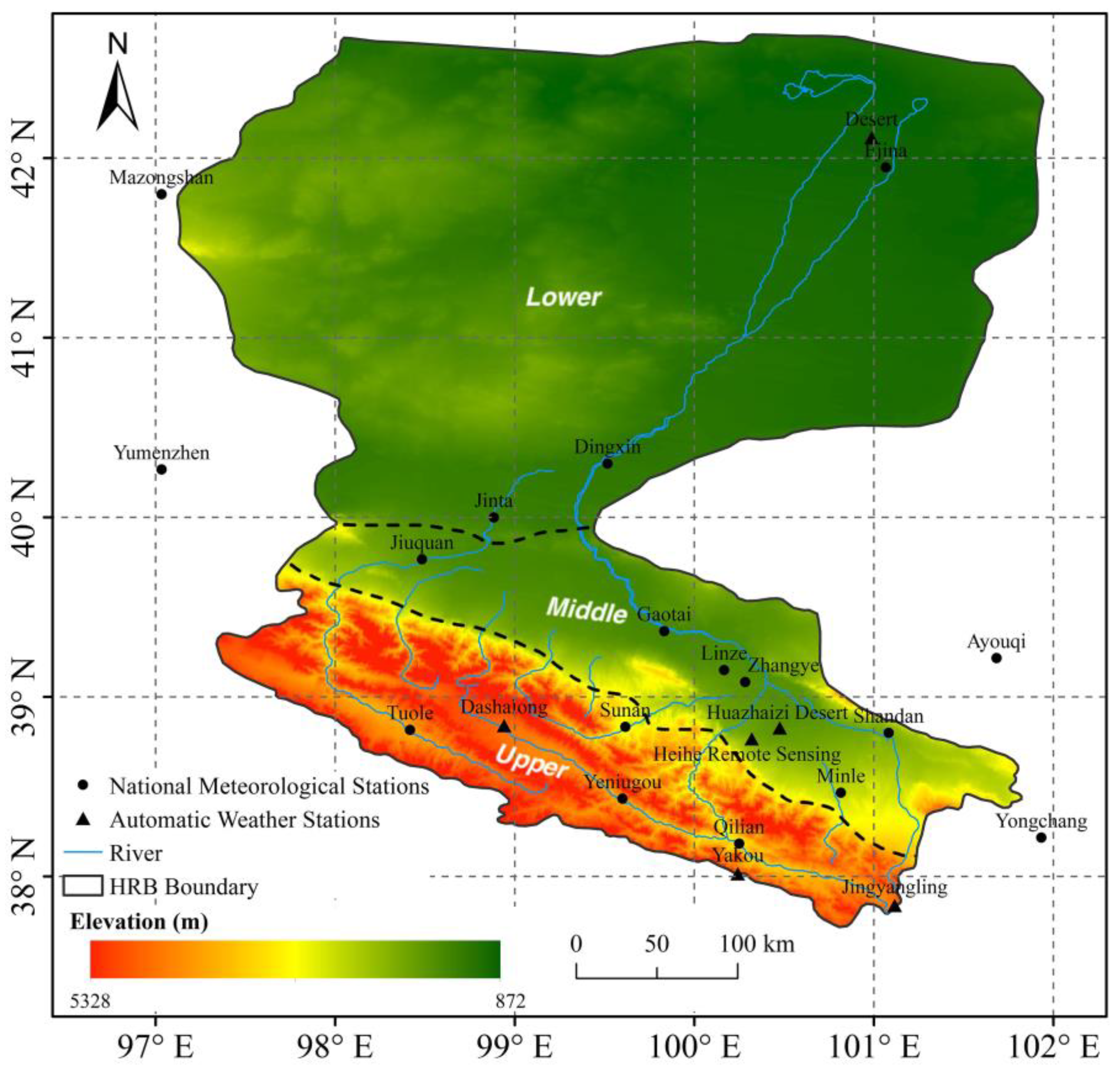
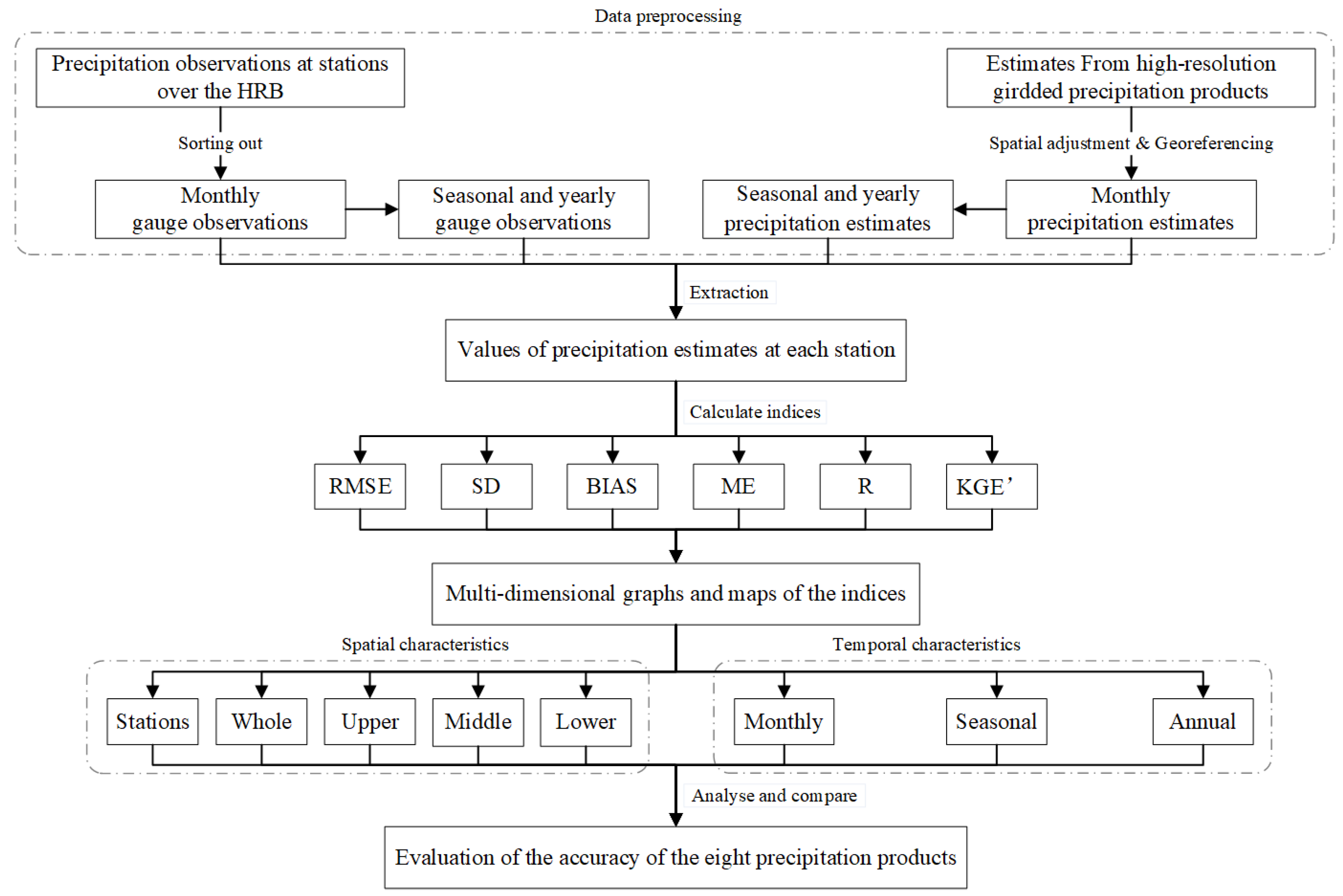
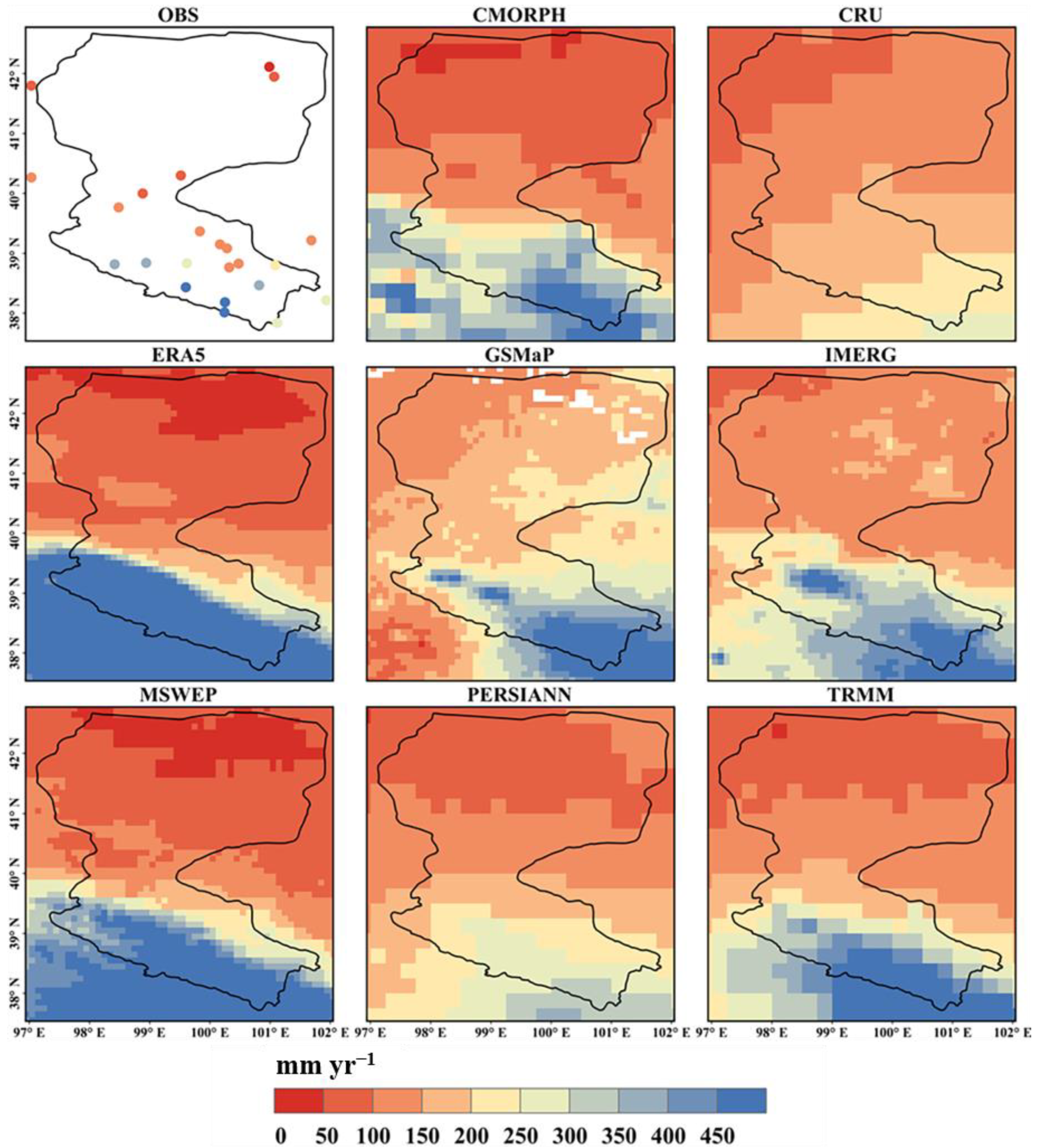
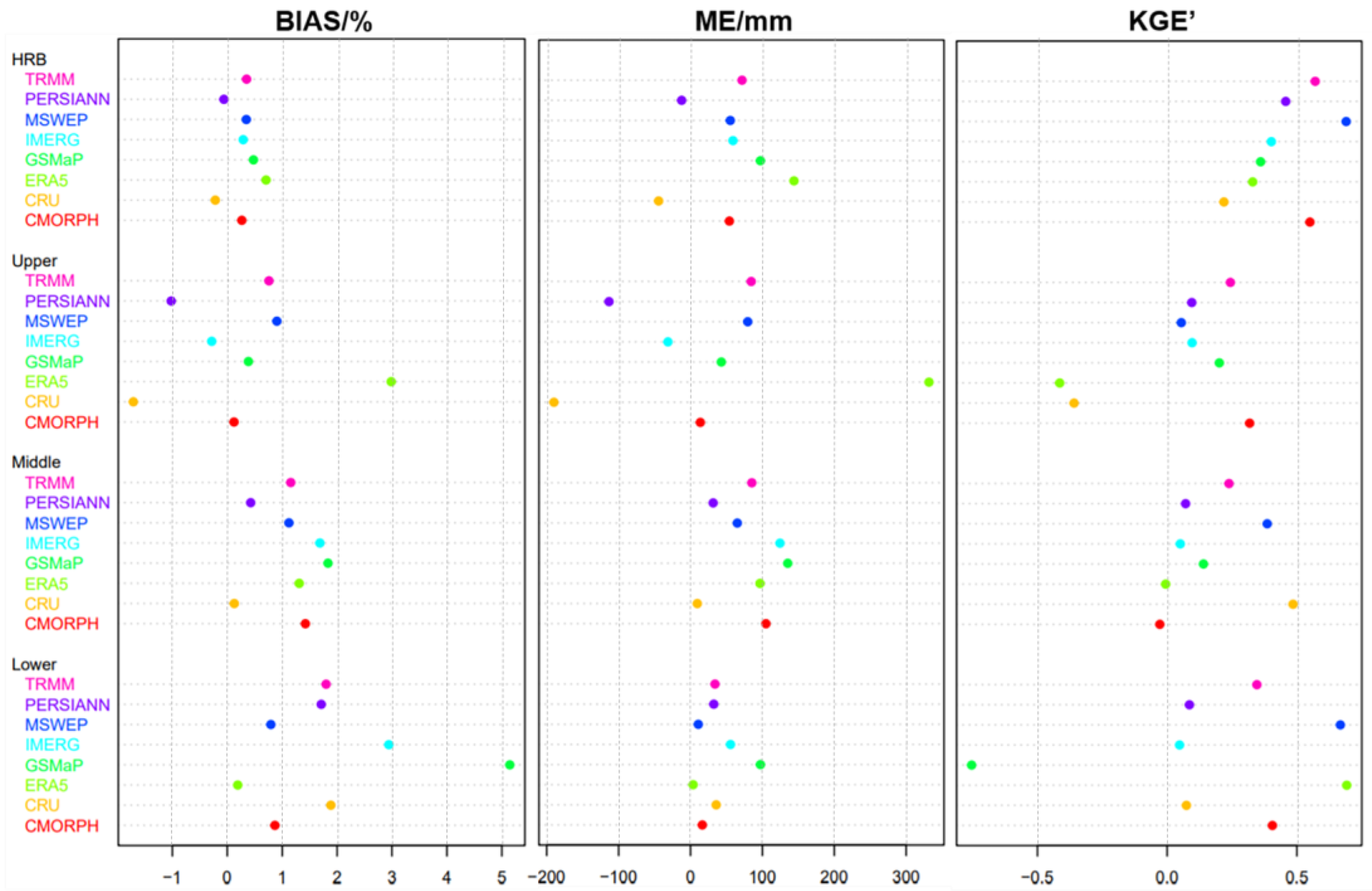
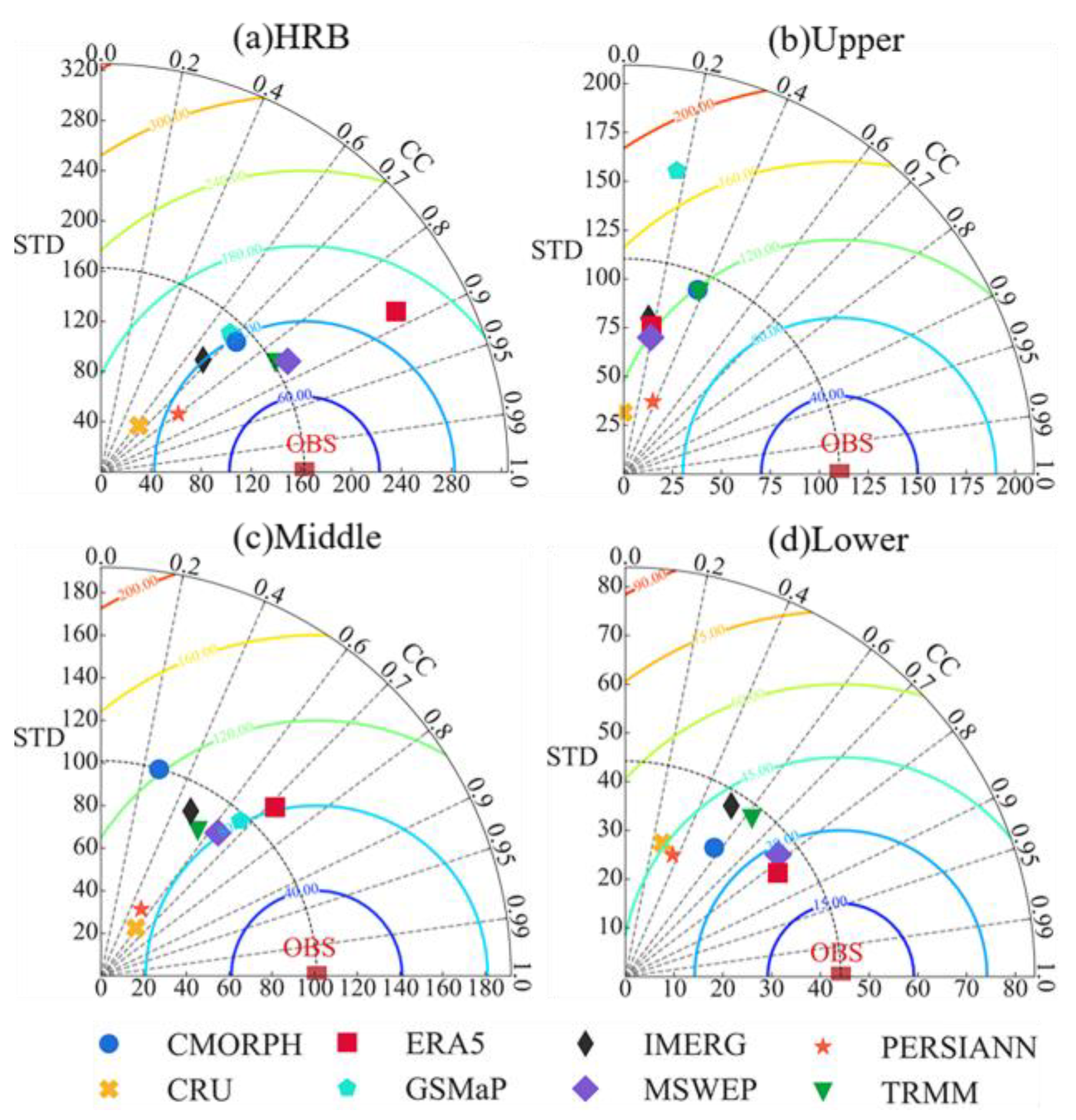
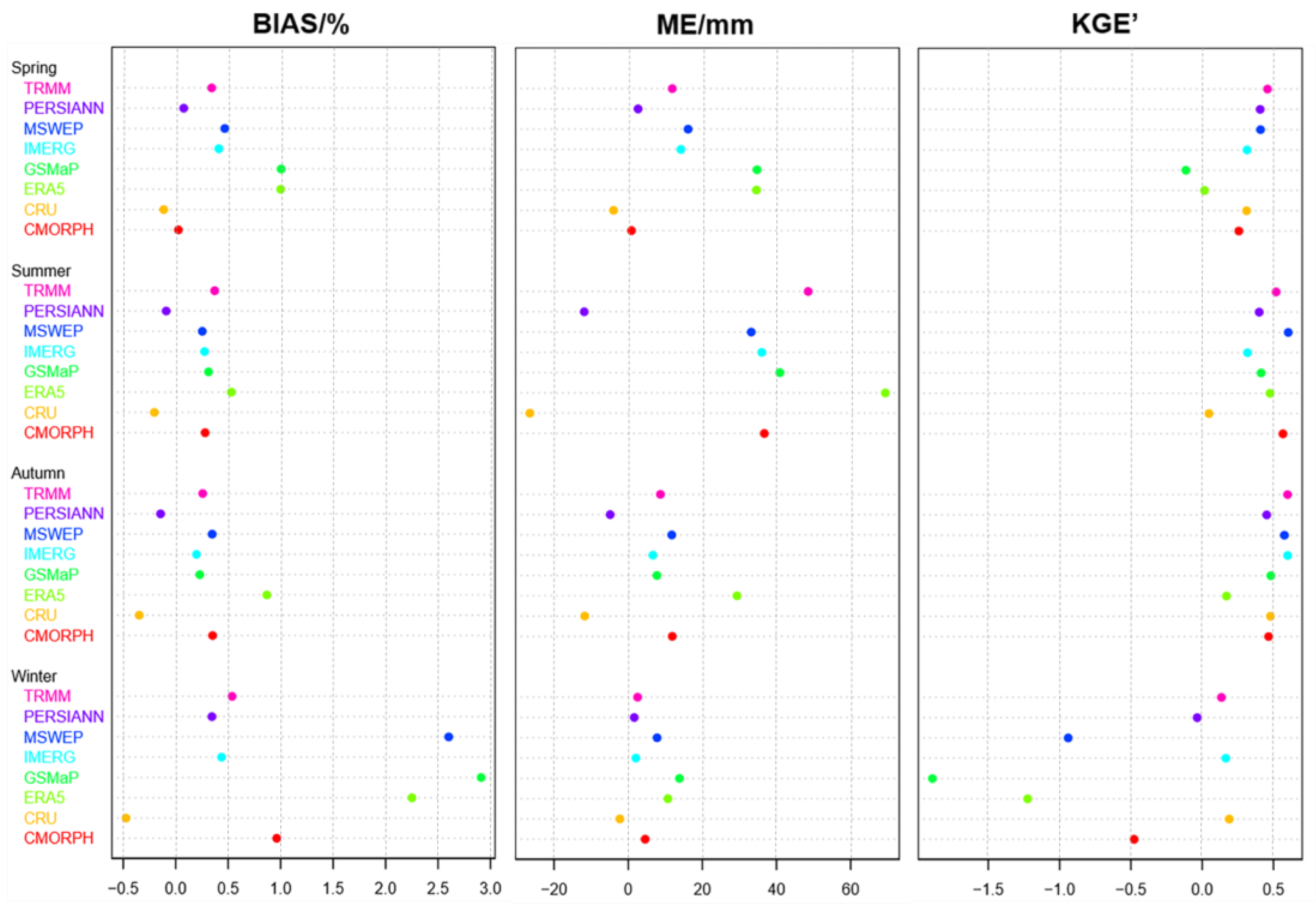
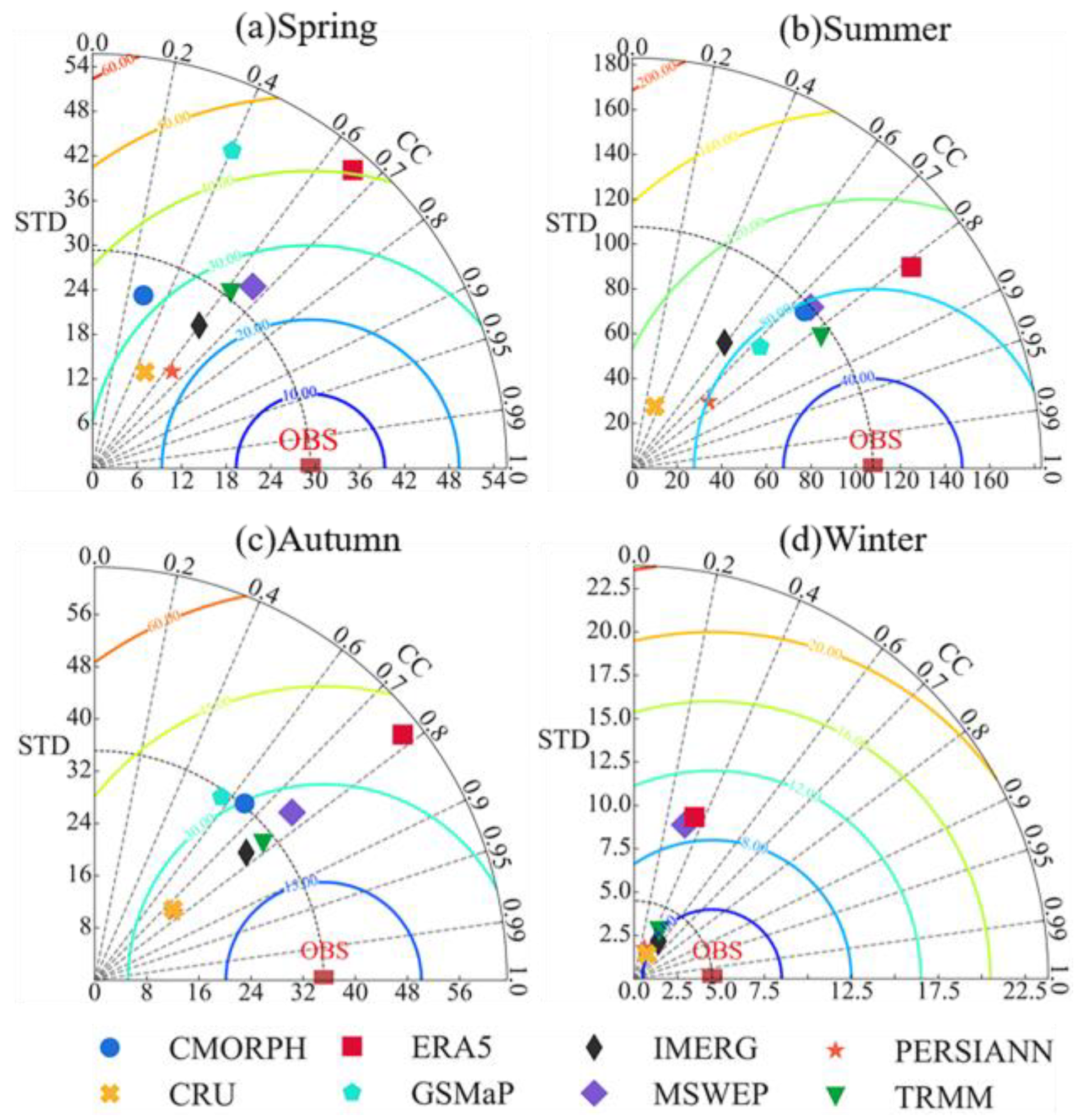
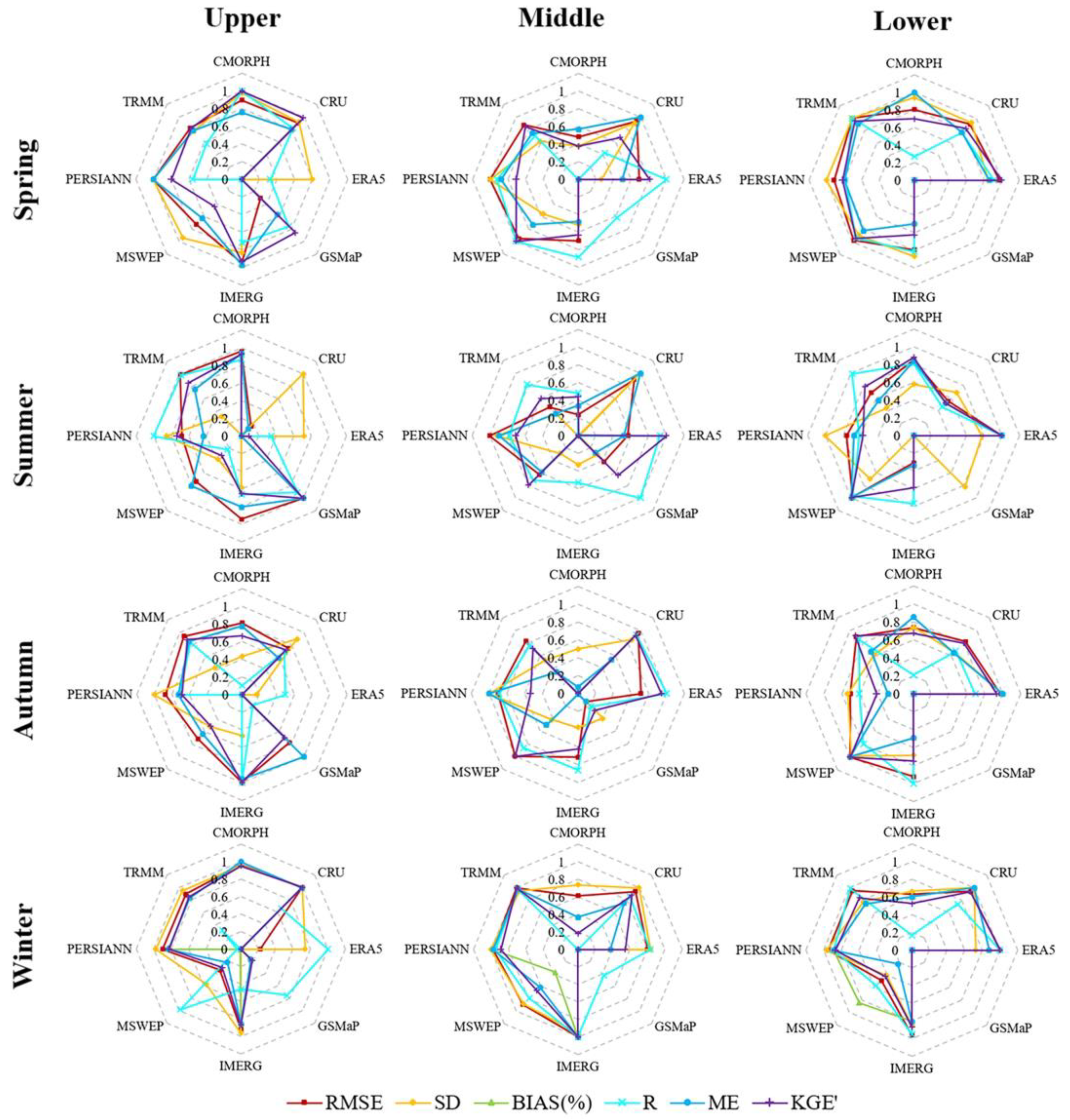
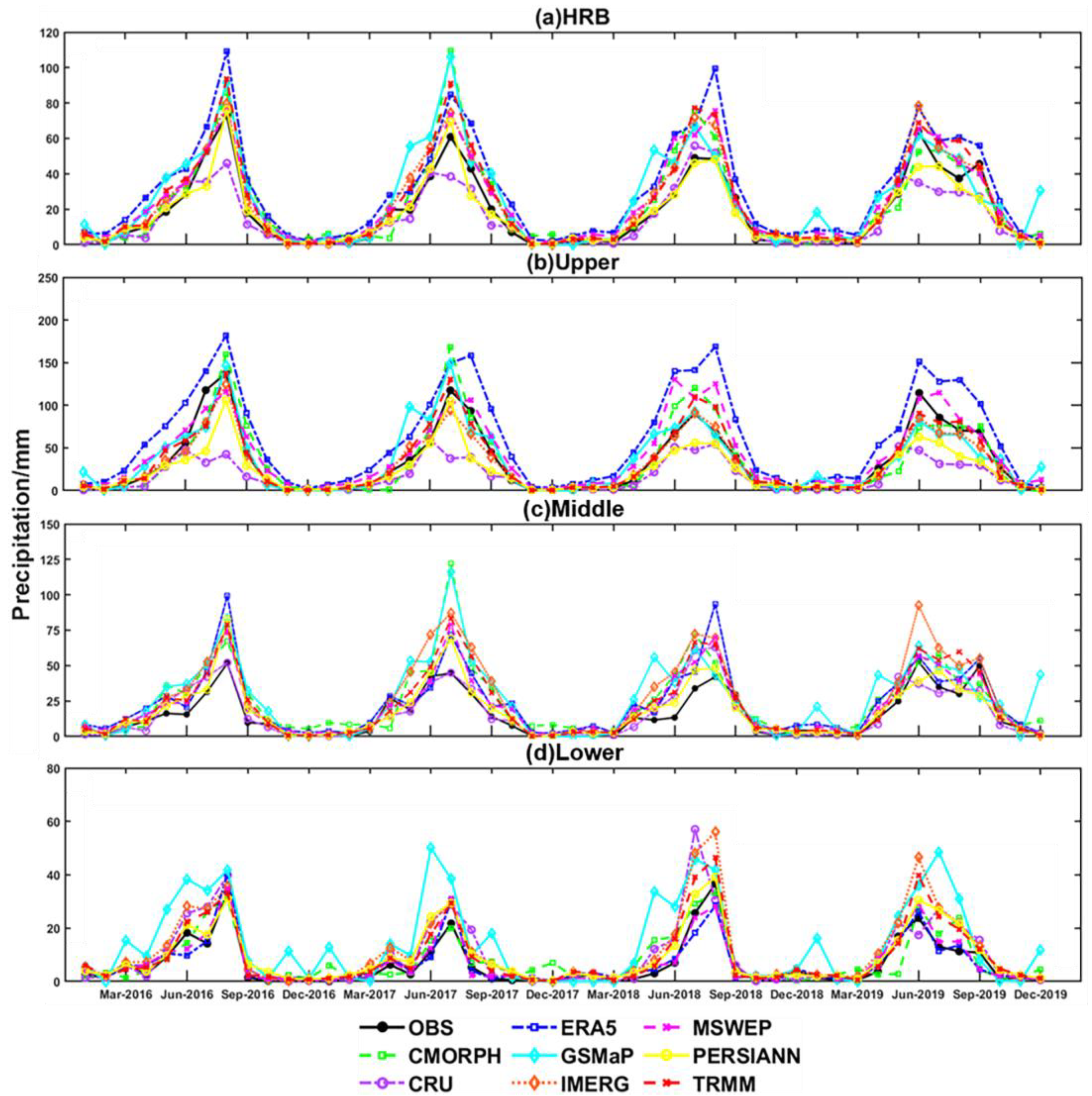
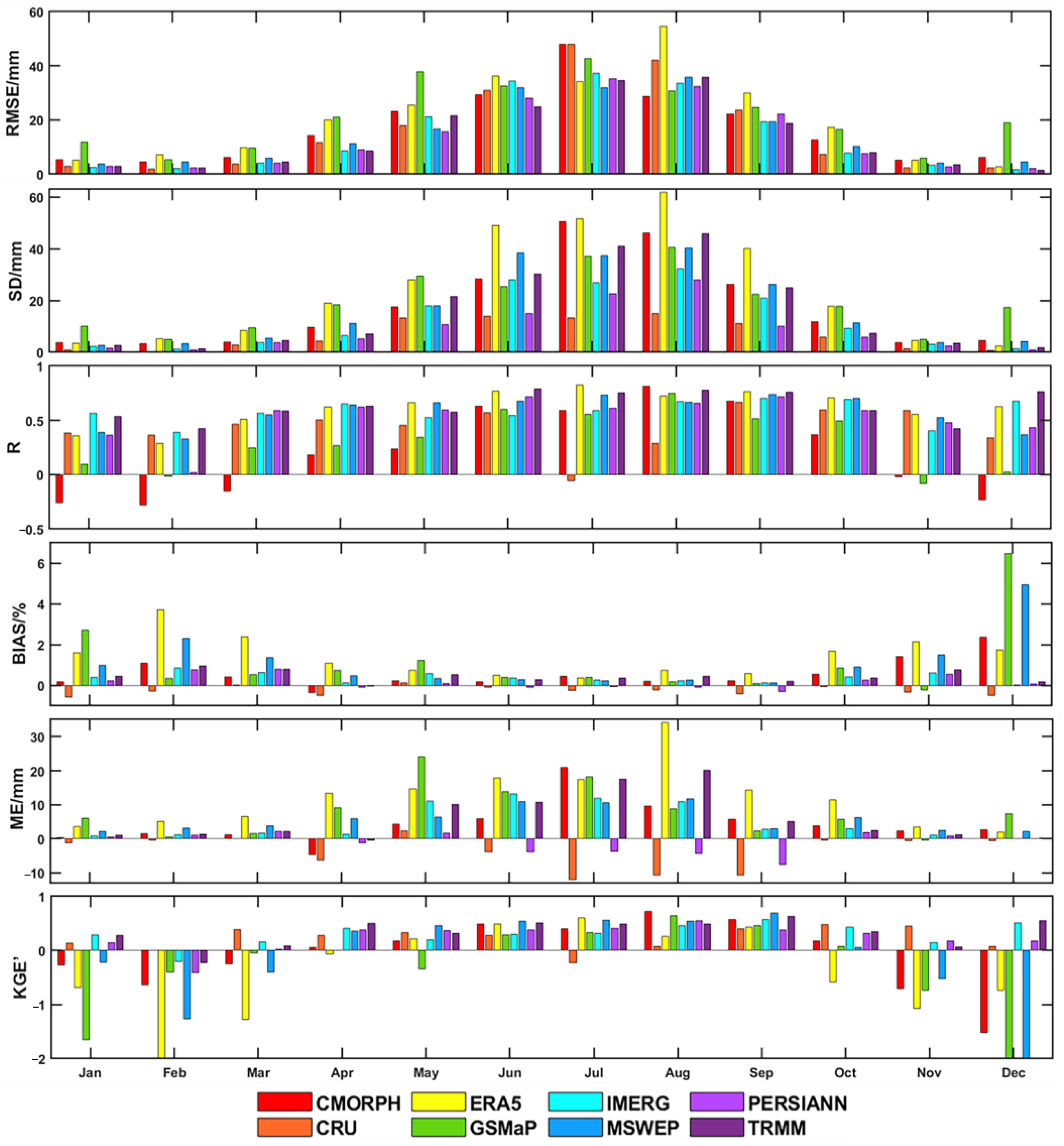

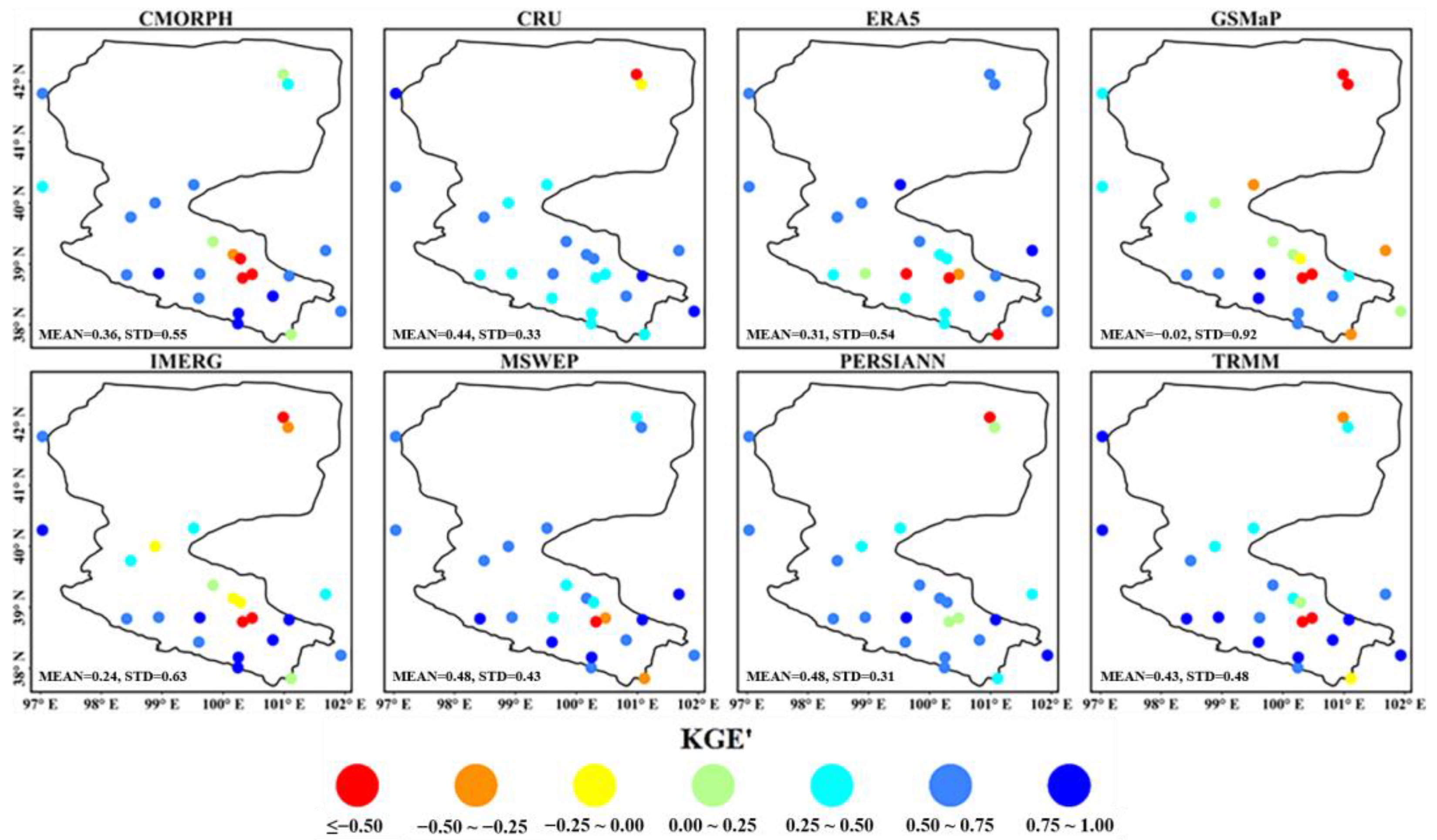

| Dataset | Resolution | Period | Coverage | Data Source |
|---|---|---|---|---|
| CMORPH | 0.25°, daily | 1998-present | 60°N–60°S | https://rda.ucar.edu/, accessed on 23 March 2021 |
| CRU | 0.5°, monthly | 1901–2020 | 90°N–90°S | http://www.cru.uea.ac.uk/, accessed on 23 March 2021 |
| ERA5 | 0.1°, monthly | 1979-present | 90°N–90°S | https://cds.climate.copernicus.eu/, accessed on 25 March 2021 |
| GSMaP | 0.1°, monthly | 2014-present | 60°N–60°S | https://hokusai.eorc.jaxa.jp/, accessed on 26 March 2021 |
| IMERG | 0.1°, monthly | 2000–2021 | 60°N–60°S | https://disc.gsfc.nasa.gov/, accessed on 28 March 2021 |
| MSWEP | 0.1°, monthly | 1979-present | 90°N–90°S | http://www.gloh2o.org/mswep/, accessed on 10 April 2021 |
| PERSIANN | 0.25°, daily | 1982-present | 60°N–60°S | https://www.ncei.noaa.gov/, accessed on 28 March 2021 |
| TRMM | 0.25°, monthly | 1998–2020 | 50°N–50°S | https://disc.gsfc.nasa.gov/, accessed on 3 April 2021 |
Publisher’s Note: MDPI stays neutral with regard to jurisdictional claims in published maps and institutional affiliations. |
© 2022 by the authors. Licensee MDPI, Basel, Switzerland. This article is an open access article distributed under the terms and conditions of the Creative Commons Attribution (CC BY) license (https://creativecommons.org/licenses/by/4.0/).
Share and Cite
Wang, Y.; Zhao, N. Evaluation of Eight High-Resolution Gridded Precipitation Products in the Heihe River Basin, Northwest China. Remote Sens. 2022, 14, 1458. https://doi.org/10.3390/rs14061458
Wang Y, Zhao N. Evaluation of Eight High-Resolution Gridded Precipitation Products in the Heihe River Basin, Northwest China. Remote Sensing. 2022; 14(6):1458. https://doi.org/10.3390/rs14061458
Chicago/Turabian StyleWang, Yuwei, and Na Zhao. 2022. "Evaluation of Eight High-Resolution Gridded Precipitation Products in the Heihe River Basin, Northwest China" Remote Sensing 14, no. 6: 1458. https://doi.org/10.3390/rs14061458
APA StyleWang, Y., & Zhao, N. (2022). Evaluation of Eight High-Resolution Gridded Precipitation Products in the Heihe River Basin, Northwest China. Remote Sensing, 14(6), 1458. https://doi.org/10.3390/rs14061458







